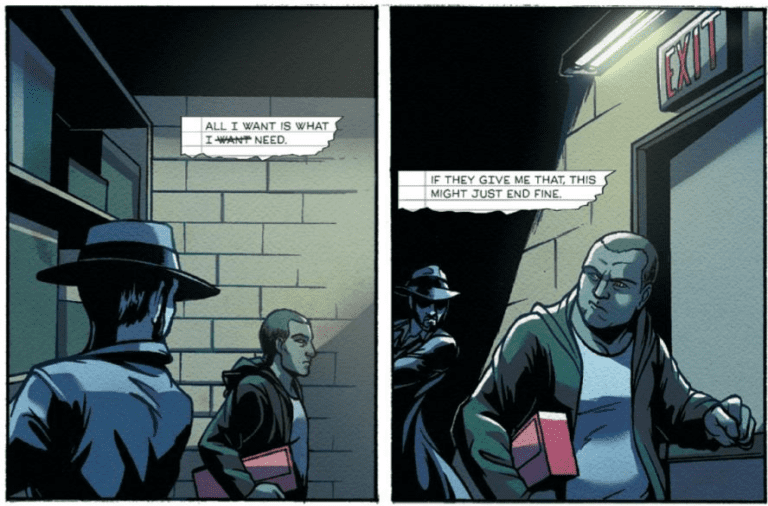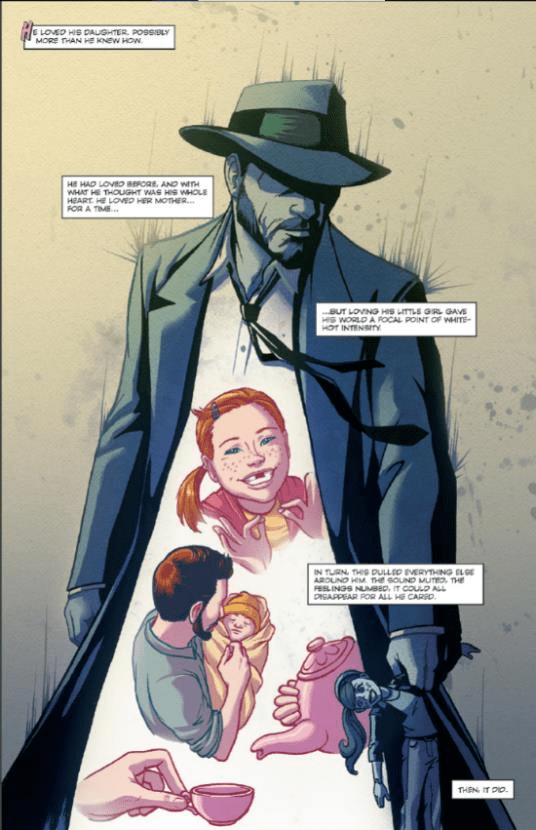“When you give a man a love the weight of the world… you have to accept the possibility of crushing him.”
How deep is a father’s love? How far will he go for his child? When everything else is taken away, nothing matters more than to see them happy. Even if it is just one last time. Ryan Lindsay’s Fatherhood is a fierce, bitter-sweet exploration of the boundaries of parenthood— how it changes a person and influences them, for better or worse. This is one of those comics that is beautiful because of its brevity, each element working together in complete harmony so that every page is brimming with meaning and heart.
A Tale Told in Colour

The colour design used by Paulina Ganucheau in Fatherhood is heavily symbolic. At a base level, the protagonists are associated with specific colours: blue for the father and pink for the daughter. Likewise, the comic itself can be broken down into three sections characterised by the predominant colour shading.
A pink colour palette is used in the first and third sections to evoke a soft tone. Here Ganucheau is illustrating that the father’s love for his daughter literally colours how he views the world, shaping what he sees as important.
This follows into the comic’s middle section, which is characterised by a blue-grey noir colour palette with increased use of shadow and motion effects. Interestingly, there are still hints of colour after this shift—on labels, the box containing the doll, onomatopoeia effects, and blood—the majority in shades of pink. This is clearly included by the artists to emphasise that the father’s driving force continues to be his daughter. Visually everything else fades away into shadowy tones, colours narrowing in upon how he can make her happy.

The brilliance of this colour theory doesn’t stop there though. Once the father’s goal is achieved pink shading is gradually reintroduced as he transitions back to his daughter’s world. This is clearest when the father comes face-to-face with his daughter, her being the only element not in blue-grey shading while he is ghostlike, a silhouette, or a figure out of frame. What’s more, the colours never completely reset! Instead, the final frames present a mix of both blue-grey and pink to demonstrate the two warring sides of the father’s love.
The content of Fatherhood demonstrates on multiple occasions the strong communication amongst its creators, and I could honestly gush about how amazing the colour theory is for
countless pages! That said, I feel the genius of Fatherhood’s artistic design is evidenced best by the first page. Here the colour symbolism is in full force, foreshadowing the thematic and narrative content of the comic. Again and again Fatherhood emphasises that the daughter is the “focal point” of her father’s world, that he will do anything for her.
Here she is the visual core of the page, literally her father’s heart. In contrast he is like armour, a barrier between the pure scenes he holds dear and the darker, marked world. Fatherhood’s artistic team should be praised for the perfect composition of this page in addition to the whole comic!
Sharp and Soft

Daniel Schneider’s art echoes these narrative and design choices, the execution of linework especially changing to match each tonal shift. Throughout the comic every panel is full of movement and depth.
Yet there are clear differences in personality between the three sections. At first the art is more sweeping, with smooth connections and flowing action. As soon as the comic enters the middle noir section, however, linework work becomes sharper, more angular and the action comes in powerful bursts.
The division between these two artistic approaches is best seen when analysing how the father’s tie is drawn and the ways in which he moves. In the pink sections his tie either hangs limply or bends on curving lines. Furthermore, while the motion of him grabbing his hat, keys, and jacket follows a direct path, there is a soft quality to it as he holds his belongings in a sure but light grip.
Contrastingly, in the blue-grey section, everything is very rigid. The father stillmoves with purpose and determination but now it has a hard edge. When pushing open the doors the movement is stiff and intense. Furthermore, his tie is drawn with sharp angles and even the corners of his collar and brim of his hat come to a point rather than being curved.
A Father’s Love

The emotional battle of the comic is reflected in its narrative voice, which Lindsay curiously elects to change alongside each colour shift. While the pink sections are delivered from a third-person perspective, the middle blue-grey section is in first person. This creates an interesting balance. Throughout the comic we receive insights into how deeply the father loves his daughter, but it isn’t until the middle section that he speaks directly to the audience. This is even represented in the captions, which change from more conventional boxes to notes written by the father on scraps of paper!
In a way the third person perspective keeps the audience at a distance while the first person perspective shows us who he truly is. Yet there is a sense that neither is the real story but rather they are two halves vying for control, each representing an extreme: love and desperation. The protagonist isn’t a noir villain, they’re just a father who wants to provide for their daughter. Then again, they also aren’t as soft and unassuming as the first section would have us believe.
In Lindsay’s own words, “Fatherhood brings out the best in a man… But it also wells up this great raging tide of other things against which the man will fight for the rest of his life.” Thus, Fatherhood follows the story of one man and his battle to control these emotions, whilst wanting nothing more than to make his daughter happy. While not a parent myself I found this message both heart wrenching and beautifully executed, and I strongly encourage readers to take their time pouring over each page, giving this comic the respect it deserves. Fatherhood can be obtained for free via Own A Indi at https://ownaindi.com/freecomics/
